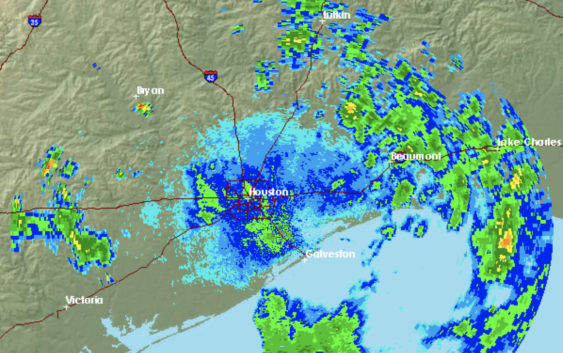- Seven months after Hurricane Helene, Chimney Rock rebuilds with resilience
- Wildfire in New Jersey Pine Barrens expected to grow before it’s contained, officials say
- Storm damage forces recovery efforts in Lancaster, Chester counties
- Evacuation orders lifted as fast-moving New Jersey wildfire burns
- Heartbreak for NC resident as wildfire reduces lifetime home to ashes
Tropical Storm Imelda Brings Flooding, Disaster Declaration to Southeast Texas

Flooding from Tropical Storm Imelda on Thursday left hundreds of people trapped in their homes and cars; led to water rescues, a hospital evacuation and power outages; and closed entire school districts, according to officials and local media.
The flooding in southeast Texas is drawing comparisons to Hurricane Harvey, which dumped more than 50 inches of water on parts of the Houston area and southeast Texas two years ago. According to the Weather Channel, Imelda is already the continental United States’ fifth wettest tropical cyclone. It dropped more than 41 inches in some areas compared to Harvey’s highest rainfall total of 60.8 inches. Still, parts of the state have been inundated worse than they were two years ago.
“What I’m sitting in right now makes Harvey look like a little thunderstorm,” Chambers County Sheriff Brian Hawthorne told ABC13.
Gov. Greg Abbott declared a state of emergency Thursday morning due to flooding in more than a dozen Houston-area counties.
The declaration will give affected counties access to state resources as they continue to respond to the flooding. The governor deployed resources, including water rescue squads, to the area Monday in preparation for the storm, according to the release.
“The State of Texas is working closely with local officials and emergency personnel to provide the resources they need to keep Texans safe from Tropical Storm Imelda,” Abbott said in a statement. “I thank our first responders who are acting swiftly to help the communities that are facing this severe weather event. I urge all those in the path of this storm to take the necessary precautions and heed all warnings from local officials.”
The counties included in the disaster declaration are Brazoria, Chambers, Galveston, Hardin, Harris, Jasper, Jefferson, Liberty, Matagorda, Montgomery, Newton, Orange, and San Jacinto.
A mandatory evacuation order was issued at 9:30 a.m. Thursday for Pinewood Estates, Countrywood Estates, and Rose Hill Acres, areas north of Beaumont, according to weather.com.
Imelda’s slow-moving thunderstorms have poured 3 to 5 inches of rain an hour on some areas since early Thursday morning, according to a report by the National Weather Service. Parts of Conroe, a city outside Houston, have received more than 11 inches of rain in 24 hours, and Galveston has gotten about 4.5 inches, the report says.
Local residents have posted photos on Twitter that show water reaching close to their knees and covering the tires of standing cars.
Houston Mayor Sylvester Turner advised in a tweet that if people are in a safe place, like work or school, they should stay in place for the next three to four hours until the area is more clear of water.
Freeways in the Houston area are flooding, Houston police Chief Art Acevedo said in a tweet. George Bush Intercontinental Airport in Houston also announced it is at a “full ground stop.”
Colby Croom, a volunteer, ventured into the storm with a boat to help rescue people in the Beaumont area, he told The New York Times. Croom’s cellphone was overwhelmed with calls Thursday morning. There were times that more than 10 people would reach out to him in the span of a minute.
Croom has helped several families escape their homes since the morning, he told the Times.
“I’ve seen water over rooftops,” he said. “I’ve seen vehicles stalled out. Man, it’s kind of like the Harvey deal all over again.”
Many parts of Houston and southeast Texas still have not fully recovered from Harvey. And areas that didn’t flood in that catastrophic storm are being hit hard by Imelda.
In 2017, Harvey swept across the Gulf of Mexico, becoming a Category 4 hurricane before it slammed into the tiny coastal town of Rockport. From there, the storm slowly moved across the state and dumped historic amounts of rain across a wide swath of southeast Texas.
Harvey’s flooding damaged or destroyed hundreds of thousands of homes. Damage estimates surpassed the $100 billion mark, and more than half a million families sought disaster relief aid. State and federal officials used the damage, which became the biggest housing recovery in modern history, as a chance to rewrite the nation’s disaster playbook. But many said those attempts slowed aid and made Texans guinea pigs.
Harvey hit Texas less than a year after a joint investigation by The Texas Tribune and ProPublica reported that unchecked development in and around Houston created short-term economic gains while increasing flood risks for homeowners and businesses. Meanwhile, climate change is only expected to bring more frequent and fierce rainstorms to the region.
Harris County voters approved a historic $2.5 billion bond package last year to finance an array of flood control projects in the Houston area. And in their first legislative session after Harvey, Texas lawmakers agreed earlier this year to draw $1.7 billion from the state’s savings account to fund repairs and flood control projects.
Although a previous version of Senate Bill 7 would have appropriated more than $3 billion from the state’s savings account, that figure changed as lawmakers negotiated budget proposals. The legislation was part of a trio of disaster relief bills that Lt. Gov. Dan Patrick identified as a priority this legislative session. It establishes two funds that would provide grants and loans for flood control and mitigation projects. Imelda comes weeks before Texas voters will decide in a constitutional election whether to create one of those funds, the Flood Infrastructure Fund.
This article originally appeared in The Texas Tribune, a nonprofit, nonpartisan media organization that informs Texans – and engages with them – about public policy, politics, government, and statewide issues.